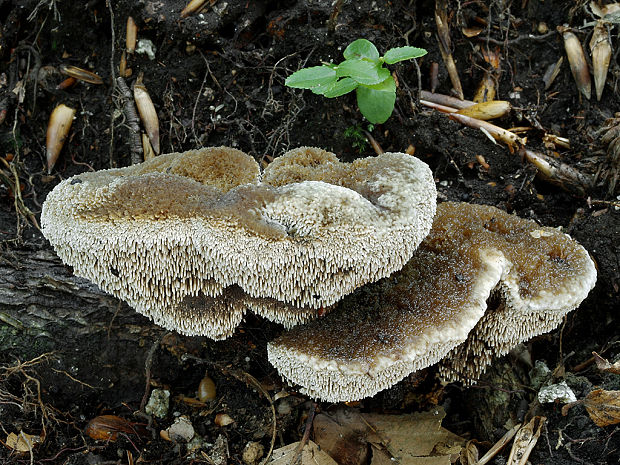- Proposed
- Under Assessment
- Preliminary Assessed
- Assessed
- VUPublished
Hydnellum compactum (Pers.) P. Karst.
- Scientific name
- Hydnellum compactum
- Author
- (Pers.) P. Karst.
- Common names
 kompakt taggsvamp
kompakt taggsvamp Myk brunpigg
Myk brunpigg jelenkovka tuhá
jelenkovka tuhá Scherpe stekelzwam
Scherpe stekelzwam lošákovec tuhý
lošákovec tuhý- IUCN Specialist Group
 Mushroom, Bracket and Puffball
Mushroom, Bracket and Puffball- Kingdom
- Fungi
- Phylum
- Basidiomycota
- Class
- Agaricomycetes
- Order
- Thelephorales
- Family
- Bankeraceae
- Assessment status
- Published
- Assessment date
- 2015-04-27
- IUCN Red List Category
- VU
- IUCN Red List Criteria
- A2ace; C2a(i)
- Assessors
- Nitare, J.
- Reviewers
- Dahlberg, A.
Assessment Notes
Justification
Hydnellum compactum is a very rare hydnoid, ectomycorrhizal species occurring in boreonemoral and nemoral broadleaved forests in Europe. Usually the fungus indicates remnants of old oak or beech forest ecosystems in very special sites of major importance for biodiversity (Brandrud 2007). Its populations are very small, have declined by at least 40% over the past 50 years and are continuing to decline. The decline of H. compactum is mainly due to modern forestry because the species disappears after clear-cutting. In addition the species appears to be very sensitive to air pollution (acid rain and nitrogen deposition), which is the main reason for its decline in Western Europe (Arnolds 2003, 2010). The number of localities is estimated to be less than 200 (including possibly unrecorded occurrences). Very few mature individuals occur in each locality, mostly only a few mycelia. Hydnellum compactum is considered extinct and in serious decline in several European countries (e.g. Arnolds and Veerkamp 2008, Krieglsteiner 2000). Using templates, the estimated number of mature individuals in Europe is less than 4,000 and the number of mature individuals in each subpopulation fewer than 250, resulting in a Vulnerable listing under criteria A2ace; C2a(i) (Dahlberg and Mueller 2011).Taxonomic notes
Hydnellum compactum is well-characterized by the pale basidiocarps with compact, yellowish context; a very strong acrid, adstringent taste and a mycorrhizal association with broad-leaved trees (Maas Geesteranus 1975). However, in the past the species has often been confused with Hydnellum mirabile (Fr.) P.Karst. In addition several other species of Hydnellum have sometimes been misidentified as ”H. compactum”. Critical revision of old collections is highly needed and the number of localities for the species might be even smaller than estimated at the moment. Molecular data suggest that H. compactum might also be present in N. America but this requires further investigation.Geographic range
Hydnellum compactum is known from temperate Europe. It occurs northwards to the south coast of Norway and south and southwest Sweden (Brandrud 1986; Gulden and Hanssen 1992a, b); southwards to Spain, Italy and Croatia (e.g. Onofri 2005). Many records are old and the number of localities might be smaller than estimated at the moment due to misidentifications (see Taxonomic Notes).Population and Trends
The number of localities is estimated to be less than 200 (incuding possible but unrecorded occurrences), but exact figures are not known. Very few mature individuals occur in each locality, most often only a few mycelia. The estimated number of mature individuals in Europe is less than 4,000 and the number of mature individuals in each subpopulation is fewer than 250, indicating a Vulnerabble listing under criteria C1 and C2a(i) (Dahlberg and Mueller 2011).
Hydnellum compactum has strongly declined in Europe during the last decades. For instance, in The Netherlands the number of localities has decreased by 94% since 1983 (Arnolds and Veerkamp 2008). In Belgium (Flandres), a 50-70% decrease has been established since 1986 (Walleyn and Verbeken 2000). The species has not been observed in eastern Germany (former DDR) since 1970 (Otto 1992). In the entire distribution area the decline is estimated as at least 40% during the last 50 years. Hydnellum compactum is included in recent Red Lists of eight European countries.
Population Trend: decreasing
Habitat and Ecology
Hydnellum compactum is an ectomycorrhizal fungus, growing with Sessile Oak (Quercus petraea), Common Oak (Q. robur) and Beech (Fagus sylvatica) in boreonemoral and nemoral forests, in some areas possibly also with Sweet Chestnut (Castanea sativa) (Maas Geesteranus 1975, Krieglsteiner 2000). The species occurs on dry to mesic, loamy and sandy soils which are very poor in nutrients (nitrogen and phosphorus) (Krieglsteiner 2000, Arnolds 2003). It is thermophilic and mainly found in forests and at forest edges with a favorable microclimate. Hydnellum compactum usually grows in areas with long ecological continuity (ancient woodlands) and it shows none or a very low ability of dispersal into younger forest stands. The species seems to prefer sunny, mosaic forest stands with old trees, often remnants of traditional, extensively grazed agricultural landscapes (Brandrud 2007). Individual mycelia can probably be very old.
In The Netherlands and Belgium H. compactum has disappeared completely from its original habitat in oligotrophic broadleaved forests due to the impact of air pollution and it is restricted nowadays to a few relict localities in roadsides with old oak and beech trees (Arnolds 2010).
Threats
Main threat to Hydnellum compactum is habitat loss by logging, destroying or severely changing the habitat of the fungus. Varied ancient woodland is rapidly decreasing in northern and central Europe, being replaced with other, single tree species stands of similar aged trees. There are no records from plantations and the species seems to disappear totally after felling of host trees. Hydnellum compactum seems to prefer sunny, mosaic forest stands and a secondary threat is that sites are abandoned from extensive grazing and selective tree-felling, resulting in more shady and dense habitats. Its occurrence as very small, fragmented and isolated populations in remnant forest ecosystem also poses a threat in itself, e.g. through accidentally exploitation. In Western Europe the effects of air pollution (acidification and nitrogen deposition) are the main threat to this fungus (Arnolds 1989, 2010).



